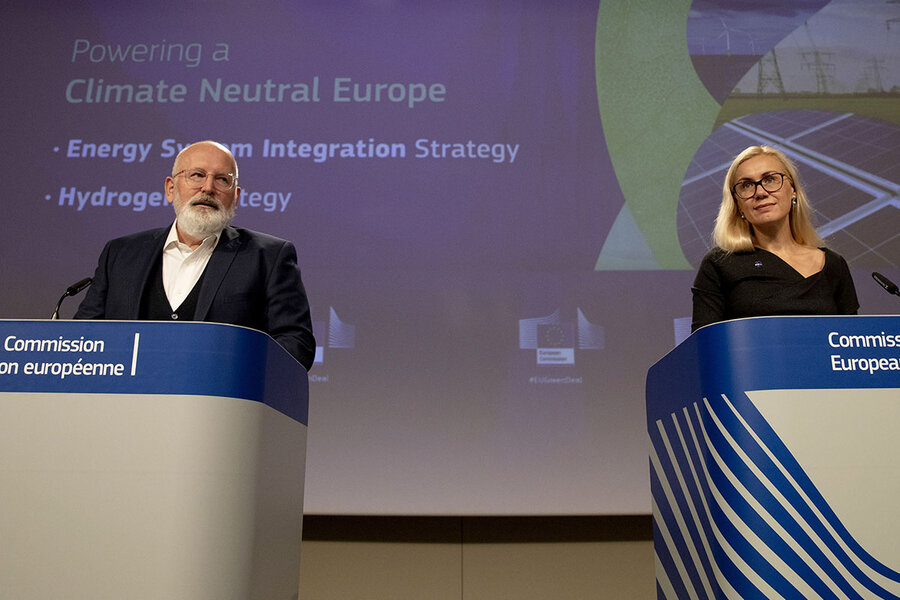How COVID-19 changed the climate conversation
Loading...
| London
For years, pleas by climate change activists for policies to slow global warming have generally fallen flat. But COVID-19 might change that.
The global pandemic has done so much economic damage, and governments are putting so much money into recovery plans, that a new opportunity has arisen to change the shape of the world economy. No longer is it assumed that carbon policy can only shift slowly and incrementally.
Why We Wrote This
Out of chaos comes opportunity, at least that's what advocates of climate action are urging governments. The post-pandemic reset could be a chance for nations to put money behind climate commitments.
For the time being, only a few national governments are taking the opportunity to invest heavily in green technologies so as to reduce carbon emissions and thus global warming. That could be because, so far, money has been spent on immediate needs – to save businesses and jobs.
Now comes the crunch. Will policymakers set out in a new, climate-friendly direction? Or will they fall back on the old, familiar ways?
“We have a choice,” U.N. Secretary-General António Guterres said last week. “We can go back to where we were, or we can invest in a better, more sustainable future.”
The theoretical has suddenly become real. Climate activists’ hopeful pleas for dramatic cuts in carbon emissions are now in front of hard-nosed policymakers, as governments worldwide perform a hard reboot of their pandemic-frozen economies.
It’s a moment without precedent. The world economy hasn’t just slowed, as it did after the 2008 financial crash. It has come close to closing down, and governments are budgeting trillions of dollars for recovery. The key question now is priorities: where the money will go.
Will it go green?
Why We Wrote This
Out of chaos comes opportunity, at least that's what advocates of climate action are urging governments. The post-pandemic reset could be a chance for nations to put money behind climate commitments.
The answer, so far, is decidedly mixed. With tens of millions out of work as a result of the pandemic, some governments seem to be prioritizing getting their old economies back on track as soon as possible, rather than changing direction so as to favor cleaner energy.
Editor’s note: As a public service, all our coronavirus coverage is free. No paywall.
But one thing has changed: The question of priorities is at least being asked in pretty much every country now plotting its path toward a post-coronavirus economic recovery.
Even before the pandemic climate awareness had been building, especially among younger people, many inspired by the teenage Swedish activist Greta Thunberg. Scientists and climate-policy experts had been intensifying calls for action amid signs that the effects of global warming were getting worse even more quickly than they had feared.
Private investors had also begun to think differently. As alternative energy becomes cheaper to exploit and deliver, returns on traditional high-carbon investments have actually been getting less attractive. Last year, BlackRock, the world’s leading asset-management firm, announced that its actively managed funds would stop investing in companies that earned more than a quarter of their revenue from thermal coal.
The COVID-19 economic shutdowns, meanwhile, dramatized the impact of human activity on climate change, as cities around the globe suddenly became cleaner, their skies clearer. And the coronavirus itself was a reminder of how the forces of nature can, if not properly understood and stewarded, upend the most comfortable of everyday lives.
Yet the key factor that has put climate policy front and center on national government agendas is the sheer scale of the pandemic’s economic damage and the extraordinarily large sums of money being devoted to recovery. The pre-pandemic political assumption that policy shifts on carbon emissions would almost always be limited and incremental is no longer operative.
The International Energy Agency caught the altered tone at a ministerial meeting last week. Declaring that the world was at a “key moment,” IEA Executive Director Fatih Birol urged that “rather than letting the COVID-19 crisis undermine our clean energy transitions, we need to take advantage of the massive economic recovery plans to achieve a definitive peak in carbon emissions and put the world on a path to sustainable recovery.”
Some national recovery plans unveiled so far have made the transition to clean energy, and thus less global warming, a priority. In Europe, the continent’s largest economy, Germany, and Denmark have said they will make clean energy an explicit building block of their revived economies. The 27-nation European Union, of which both are members, has unveiled a recovery plan devoting 25% of an $850 billion overall package to a “green new deal” that would cut carbon emissions.
In Asia, the picture is mixed. South Korea has announced a green new deal of its own, pledging to support renewable energy and phase out dependence on coal. Critics, however, have dismissed the government’s plans to invest only $11 billion over two years in this project as insufficiently ambitious.
Similar doubts have been raised about the scale of clean climate investment in Japan. And other Asian countries, including India and Indonesia, have so far shown no sign of significant focus on climate change as part of their recovery plans.
The key state is China – the world’s second-largest economy and its largest carbon emitter. There, the jury is still out. The government has pledged that one major focus of its $500 billion recovery fund will be on new infrastructure, such as ultra-high-voltage electricity transmission. It’s also reportedly considering increasing the number of charging stations for electric vehicles. More broadly, it is moving aggressively on research and development of the kind of new technologies likely to be key in future clean energy networks.
Still, in the first half of this year, China also stepped up the pace at which it opened new coal-fired power plants – a traditional remedy when the government is chasing quick and easy economic growth. And with the immediate priority likely to be shortening the coronavirus-related downturn, clean energy projects could take a back seat.
In other major economies, there are also signs of at least a short-term drive to protect existing energy companies in order to spur a return to growth. In Russia, Australia, Canada, France, and even South Korea, government support for fossil fuel businesses so far has been outweighing investments in clean energy.
That’s also true of the world’s largest economy, and second-largest emitter: the United States.
President Donald Trump has yet to set out the kind of recovery program that other countries are launching. So far, most of the federal government money earmarked to cope with COVID-19’s ravages has been aimed at saving businesses and jobs.
Mr. Trump has in the past been dismissive of scientists' warnings about the effects of global warming. His rival in the upcoming presidential election, former Vice President Joe Biden, this week announced a $2 trillion economic investment plan focused on reducing carbon emissions. But the election is still four months away, and the Trump administration faces a more immediate challenge, with COVID-19 cases still on the rise in a number of states.
Amid the mixed signals, and relatively few dramatic new examples so far of clean energy commitment, there is concern among climate activists that the post-pandemic investment “moment” could be lost.
At last week’s IEA meeting, United Nations Secretary-General António Guterres appealed to national governments to recognize that their recovery plans represented a crossroads. “We have a choice,” he said. “We can go back to where we were, or we can invest in a better, more sustainable future.”
Editor’s note: As a public service, all our coronavirus coverage is free. No paywall.










